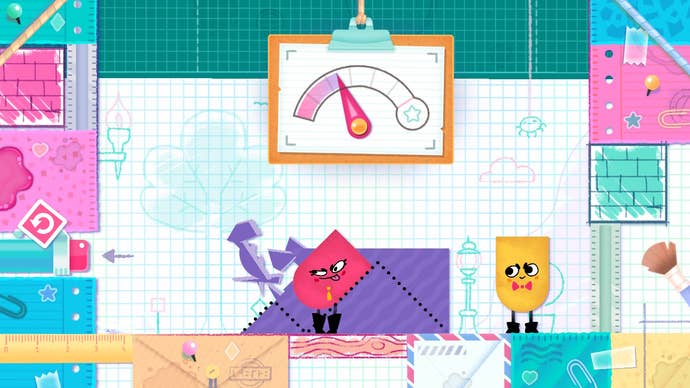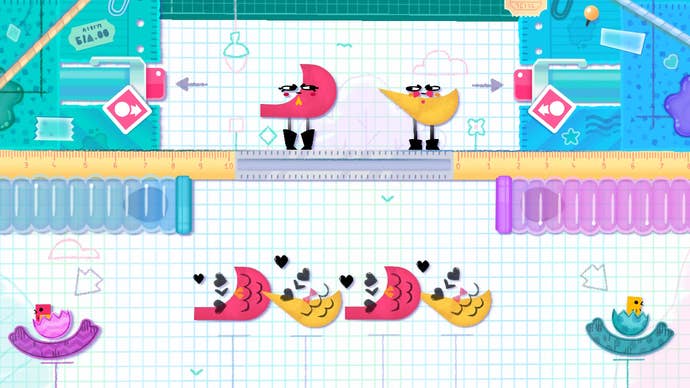Tangles and Snips: How Two Brothers Went From Flash to Nintendo and Apple
How chance connections helped these brothers continue making the things they enjoy.
This article first appeared on USgamer, a partner publication of VG247. Some content, such as this article, has been migrated to VG247 for posterity after USgamer's closure - but it has not been edited or further vetted by the VG247 team.
At one point, Adam Vian laments to me about the work he had done on Crush the Castle. It was a series of Flash games about crushing castles with a trebuchet that ultimately had its mindshare robbed by a little project called Angry Birds. "I feel like if the universe had been slightly differently aligned, I would be a billionaire at this exact moment," Adam jokes.
Angry Birds aside, Tom and Adam Vian have a history of being in the right place at the right time. The brothers have made a number of games over the years, and an absolutely massive catalog when considering not just their console or Steam games, but Flash development as well.
They got their start on early Flash-centric websites that hosted the free games that dominated every millennial's computer lab screens. And with time and each successive project, they stepped forward, until it wasn't a website they were developing for but Nintendo.
Behind games like Snipperclips and Tangle Tower is a pair of developers who have built up a legacy of games they enjoy, while still finding increasing success with each one. As Adam tells me, they know what it's like to make a game that's slightly misguided; something that "doesn't exist on the Internet" quite yet.
Looking at the history of this pair of Flash developers, their path speaks for itself. Even if they missed one chance, they've still proven game after game that they can chase their passions and still thrive.
When I sat down with the brothers at PAX East earlier this year, they were showcasing Tangle Tower, a detective mystery that was an Apple Arcade launch game and had since made its way to Steam and the Nintendo Switch. It's a continuation of a previous game of theirs, Detective Grimoire, but it's a little harder to showcase than others due to its story-based nature; it's the opposite end of the spectrum from one of the duo's previous projects, the co-op puzzle-game Snipperclips.
Despite it then being near the end of February 2020, the conversation drifts toward Untitled Goose Game. The indie darling has what Tom calls a "special magic," where not only do you understand what's going on in the first GIF you see of it, but can immediately imagine yourself playing and exploring the game.

"I heard a really good quote where it's like, game design has two starting points for the players," Adam says. "One where they first start imagining the game after seeing it, and one where they actually get their hands on it. [Untitled Goose Game] is a good example, Snipperclips is a good example, where you see it and go, 'Oh I would do that differently. I would want to try this. I want to see if this works.'"
Breaking New Ground
Their development history comes from humble origins, in making short cartoons and video games in Adobe Flash. Adam and Tom's interest synchronized neatly; the former fell into art and animation, while the latter went into programming.
The sometimes-messy world of Newgrounds has spawned a number of notable independent developers over the years, including Castle Crashers and Alien Hominid studio The Behemoth. As the brothers tell it, the site was also grating at times, as it was their first brush with heavy criticism from a devoted base.
"Boy, that was a good lesson early on in getting pretty horrifically abusive reviews and beginning to shrug them off," Tom says of Newgrounds' user reviews section. The two kept making games, eventually resulting in quirky adventures like Blue Rabbits Climate Chaos for Armor Games. Under the pseudonym of the Super Flash Bros., the pair built up a catalog of games, eventually garnering a sponsorship from Armor Games, which let them do things like pay a composer. All the while, they were charting a course; this was pre-App Store, pre-Steam. Adam tells me there was nothing similar to the paths indie developers are able to take today.
Tom worked on various projects like casino and children's games, while Adam finished out his university studies for illustration. Eventually, they were approached by Armor Games to make an iPhone game, and over the course of four years and a Kickstarter, they created Detective Grimoire.
Inspired by Phoenix Wright and Professor Layton games, the brothers went through a much larger process, including almost having to switch off Flash until an Adobe update fixed iPhone compatibility. The result was, ultimately, successful; or at least as successful as the pair needed it to be. "It did well enough that we continued to make games, which is more than a lot of people get to do, which is amazing," Tom says.
Looming on the horizon was a massive opportunity, though. They just didn't quite know it yet. The duo decided, one day, to have a one-day game jam, for no other reason than to have a palate cleanser. On Friday, they both decided to come back Monday with three ideas, and they'd pick the best of the six.
One of them was just a simple animation of characters cutting shapes out of each other. "Tom made it in that same day, and we were laughing out loud by the end of the day with the prototype," Adam says. "It was like, okay, this is it. This is genuinely, immediately fun."
They spent a few weeks making a prototype and started sending it around to a handful of independent publishing houses. Alongside the usual suspects, the pair decided to shoot their shot—at a recent EGX event, they had made contact with a rep for Nintendo. They knew their game was going to be co-op, and the prospect of a console publisher seemed more promising because single-screen PC co-op games were a less common sight then (even now).
Surprisingly the indie publishers passed on it, but Nintendo was interested. The Super Flash Bros., now SFB Games, had just landed a pitch at one of the world's largest gaming companies. "I like to credit Nintendo for having the foresight to look past the slightly rough prototype and see a game that was worth making," Adam says.

Though it was officially a Wii U game at first, the newly dubbed Snipperclips would become a launch game for the next Nintendo console: the Switch. Seemingly overnight, SFB Games had jumped up from scrappy prototype to launch game developer. "We went from just being an indie publisher putting stuff on the iOS and hoping to get a feature to, oh no, you're going to be day one on the new Nintendo console, and it's a Nintendo game," Tom says. "So it was not even like a curve. This is something else entirely."
The brothers lead the development on Snipperclips, but the new wonder was having Nintendo's backing on things like localization and marketing. Nintendo pressed the co-op angle, and by pricing it at a $20 mark, it provided an interesting tack-on purchase for early adopters. The same-screen, single Joy-Con co-op was an immediately understandable way to show the Switch's party game potential.
It got popular, even if that popularity didn't always carry over to the brothers. They both joke about how some people just thought Nintendo itself made Snipperclips; at one point, Adam visited a special Switch launch event in London with longtime SFB collaborator Catherine Unger, and the reps were baffled at how good the former was at Snipperclips.
"Yes, I've played this level 8,000 times," Adam recalls thinking at the time, laughing. "I play it in my sleep."
Rising Towers
For their next project, the brothers already had an idea of what to do. Before Snipperclips had taken off, they had started production on a game called Tangle Tower—a sequel to Detective Grimoire, with partial funding from an EU grant. They dropped everything on Tangle Tower to work on Snipperclips—"you drop everything for Nintendo"—and then returned to Tangle Tower.
The two games could not be on further ends of the design space. Snipperclips is a physics-based co-op game with virtually no story while Tangle Tower is driven by narrative, filled with quirky characters and classic adventure puzzles.
It wound up being a good change of pace, however. Adam tells me they were so exhausted from making a physics game that it was "super refreshing" to go back to character-driven storytelling. Tom jokes about the difference in testing and polishing the two: "There's a hundred-percent success [rate] of clicks to the things you're going to do," he says.
But Snipperclips' success didn't see the brothers resting on their laurels; if anything, they were more ambitious. If they weren't going to make more games in the style of Snipperclips, they needed to make something "equally amazing." So they decided to go back and spend time on Tangle Tower, ultimately putting another two years of development on it.

It was during this time that the pair had caught the attention of Apple, thanks to a little side project called Marching Order. The company noticed the game on the iOS Store and reached out about getting them involved in Apple Arcade, an at-the-time secret development.
Tangle Tower, as they tell it, was 90% finished at that point. Bumping it to Apple Arcade took it to about 80%, but they ultimately decided it was the right call. Tom reassures me they met the deadline without burning out on it ("Is that true?" Adam chimes in, laughing) and Tangle Tower launched with Apple Arcade.
Though it's not quite comparable to the console titan that is the Switch, Apple Arcade ended up being advantageous in some ways. The week Apple Arcade launched, a little game called the Untitled Goose Game launched and instantly dominated headlines everywhere. "In any other situation, that would be a disaster because you got buried by everything," Tom says.
But Apple Arcade ended up providing a steady stream of new players to Tangle Tower. Its presence on the service offered, at least for a time, what Adam calls a "baseline visibility." While Tangle Tower's eventual Switch and Steam launches didn't make as much impact on launch, Apple Arcade provided a steady influx of players over time rather than one immediate burst.

With Tangle Tower out now on several platforms, the two have mostly been promoting that while considering what comes next. There are a lot of questions: which platform, what style of game, or what sparks their fancy.
It seems like whatever they decide on, it will certainly be something they enjoy making. These Super Flash Bros. have spent most of their career doing the things they want to do and seeing it pay off. That's not always easy in this industry, but they've fared well in the earliest days of independent development and seem likely to continue doing so.
Before we break, Tom tells me about his dream of marrying together the duo's two recent hits, Snipperclips and Tangle Tower, into a single game that is mechanically fascinating, but also atmospheric and rich. He's not sure it's possible, but it's something they want to chase. Maybe the stars will continue aligning for the pair.
"What an extraordinary privilege that we get to do that and it works," Tom says. "Some day our luck will run out, but we're going to ride the wave for as long as we can."










